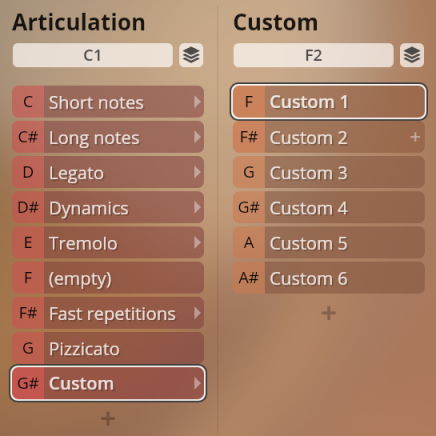previously "SYNCHRON-ized Chamber Strings Sordino"
Studio Chamber Strings Sordino was specifically created to enrich your tonal palette with a nuanced, intimate, yet expressive and dynamic small string ensemble sound, which not only covers the entire spectrum of chamber music literature, but can also enhance any larger string orchestra.
The Presets of each instrument group are subdivided into 8 different Articulation categories (plus a ninth named "Custom", ready for your own creations):
- Short notes
- Long notes
- Legato
- Dynamics
- Tremolo
- Arpeggios
- Fast repetitions
- Pizzicato
The (empty) slot is inserted for compatibility reasons with other collections.
Within these Articulation categories, you can select a Type (if applicable), e.g., normal or fast legato, and for some of the types there are additional options available, .e.g, vibrato variants.
Studio Chamber Strings Sordino offers three basic Preset types for every section in separate folders named "VelXF sus - MOD", "VelXF - MOD", and "Velocity". In the first, velocity crossfading is only activated for long notes, while the dynamics of short notes as well as marcato options are controlled by keystroke velocity, thus facilitating phrasing. In the second, all articulations have velocity crossfading activated so that you can control dynamics with MIDI controller CC1, the modwheel. Velocity crossfading can be enabled or disabled by clicking its on/off symbol in the Synchron Player's Perform tab, or you can use the 'Velocity' Preset where the dynamics are generally controlled by keystroke velocity.
Apart from the individual string ensembles, there are also Presets combining all ensembles, which you will find especially useful for quick layouts and for playing an entire string orchestra live!
Patches can be used to build your own custom Presets and adapt the Synchron Libraries to your specific requirements.
For Studio Chamber Strings Sordino, our software developers added a specifically designed convolution reverb derived from Vienna MIR Pro to the Synchron Player, featuring the outstanding and unique ambience of the 540 m2 (5,813 sq.ft.) main hall of Vienna Synchron Stage. The perfectly engineered reverberation and placement presets combine customized impulse responses with expertly crafted reverb settings for each group of the ensemble. By adding the ambience of Vienna Synchron Stage’s Stage A to the dry samples in real-time, Studio Chamber Strings Sordino perfectly blend with any other product of our Synchron Series.
For each ensemble, there are Mixer Presets that depict different recording situations and sound options: Close, Classic, Wide, Distant, Ambient, Narrow Close, Narrow Ambience, Silk, Compressed Silk, short and long reverb without convolution, and MIR unprocessed. In the two ‘Narrow’ Presets, the ensembles are placed closer to each other, like in a chamber orchestra. Please note that these are not compatible with other Synchron Strings collections.
For designating pitch, the Vienna Symphonic Library uses International Pitch Notation (IPN), which was agreed upon internationally under the auspices of the Acoustical Society of America. In this system the international standard of A=440 Hz is called A4 and middle C is C4. All pitches are written as capital letters, their respective octave being indicated by a number next to it. The lowest C on the piano is C1 (the A below that is A0), etc.
The Synchron Player software allows you to set middle C to C3, C4, or C5 according to your preference. Selecting another setting than C4 will of course also change the play ranges and keyswitches accordingly.
The collection’s Presets comprise all recorded Patches in Articulation groups, which again contain Types of the respective Articulation, with further options if available.
By default the keyswitches for Articulations are mapped from C1 to G#1 (for Middle C = C4) for violins, violas, and cellos, and C5 to G#5 for the double basses. For the available Types, the keyswitches start from F2 for violins and violas, and from F6 for cellos and basses.
Additional options within Articulations or Types are offered by the Dimension Controllers. The controller function is indicated by the respective caption, as of course it may take on different tasks as needed.
Strings all Preset
Apart from the individual string ensembles, there are also Presets featuring Patches containing all ensembles. They are especially useful for quick layouts and for playing an entire string chamber orchestra live!
Mapping range: B0–A#6
- Basses: B0–B2
- Cellos: C2–B3
- Violas: C3–F#4
- 2nd violins: C4–A#6
- 1st violins: G4–A#6
Articulation keys: C~–G#~
Type keys: starting at F0
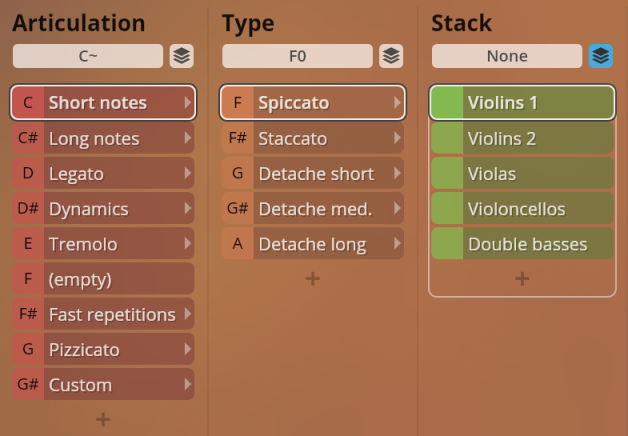
Spiccato, staccato, short, medium, and long détaché.
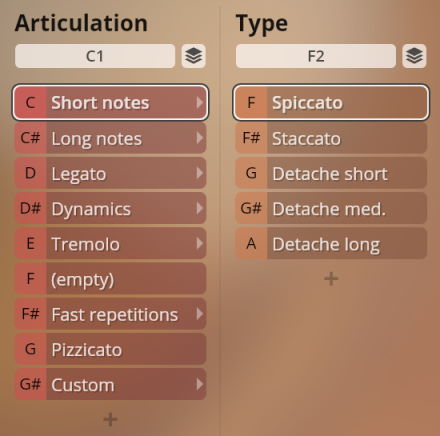
Sustained notes, normal and with marcato option.
Use Dim.Ctrl/B (CC3) to switch between vibrato and no vibrato as well as the vibrato/no vibrato crossfading option.
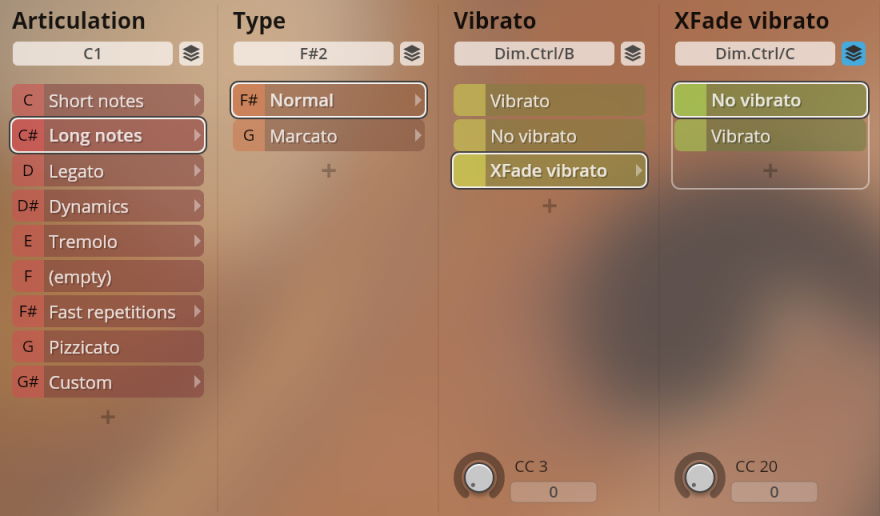
XFade vibrato
Use Dim.Ctrl/C (CC20) to crossfade between vibrato styles.
As above, but with the option to add marcato attacks to the notes. Marcato amount control depends on Preset type (see above).
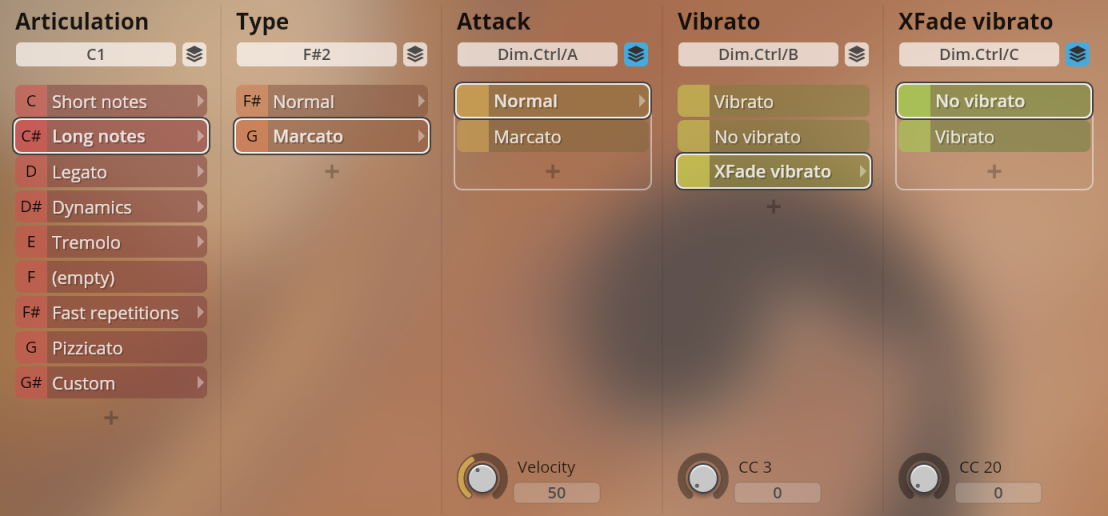
Performance legato with normal, marcato, fast, slurred, portamento, and Auto-speed. The basses have no slurred articulation, so that type slot remains empty.
Use Dim.Ctrl/B (CC3) to switch between vibrato styles and the vibrato crossfade option.
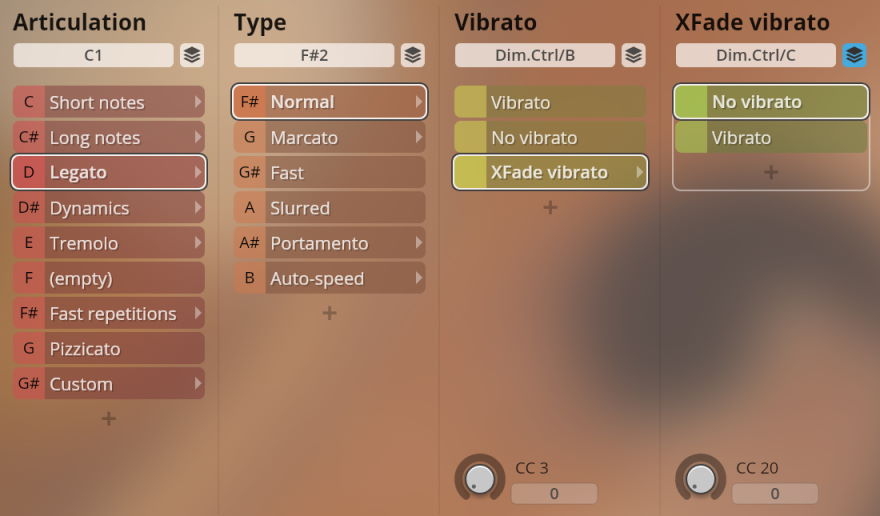
As above, but with the option to use Dim.Ctrl/A to add marcato attacks to the notes. Marcato control depends on the selected Preset type (see above).
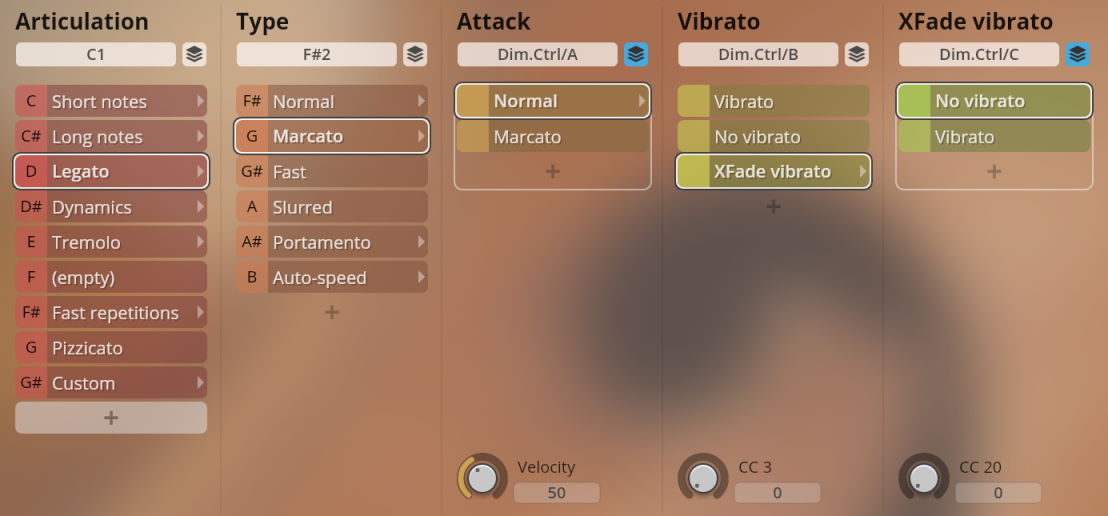
This option implements a speed controller on Dim.Ctrl/D to switch automatically between normal and fast legato.
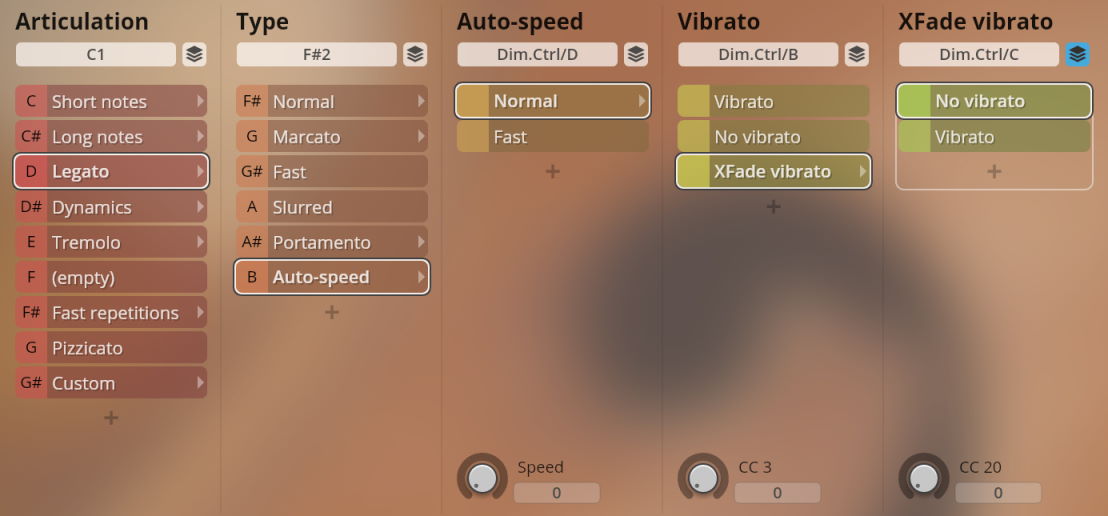
Sforzato, fortepiano, sforzatissimo, crescendo and diminuendo 1/2/3/4 seconds, and crescendo-diminuendo 2/3/4/6/8 seconds.
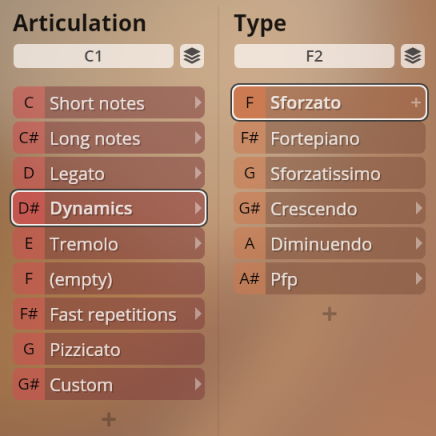
Use Dim.Ctrl/B (CC3) to change duration.
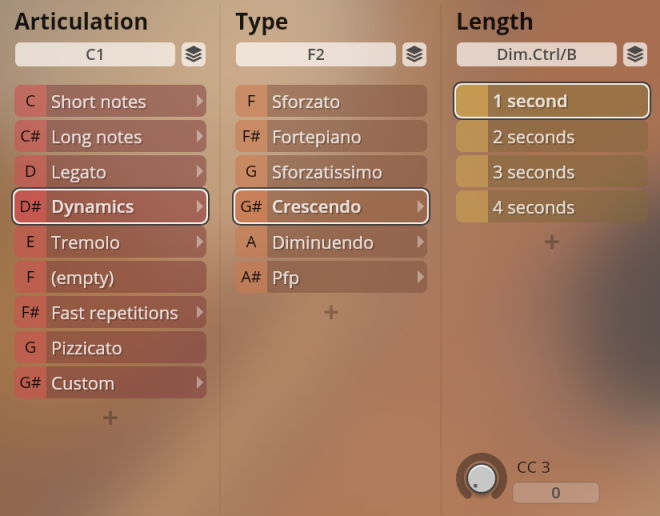
Tremolo sustained, with the option to add a marcato attack to the notes with Dim.Ctrl/A. Marcato control depends on the selected Preset type.
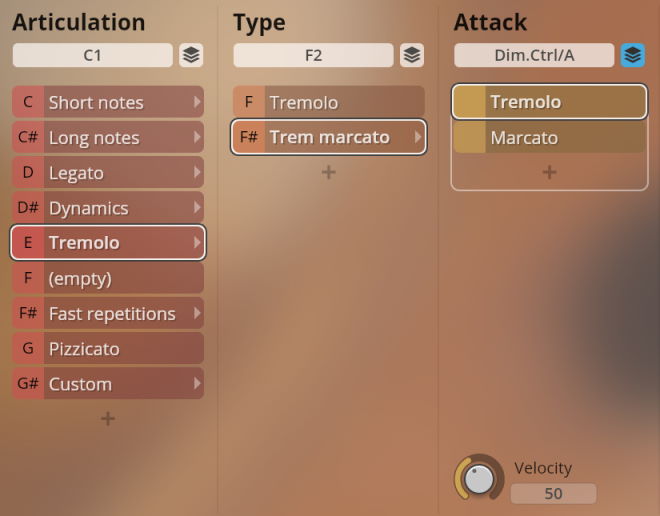
Fast repetitions from 150 to 190 BPM with ringing and cut release.
Release switch: C2/D2 (violins, violas), C6/D6 (cellos, basses)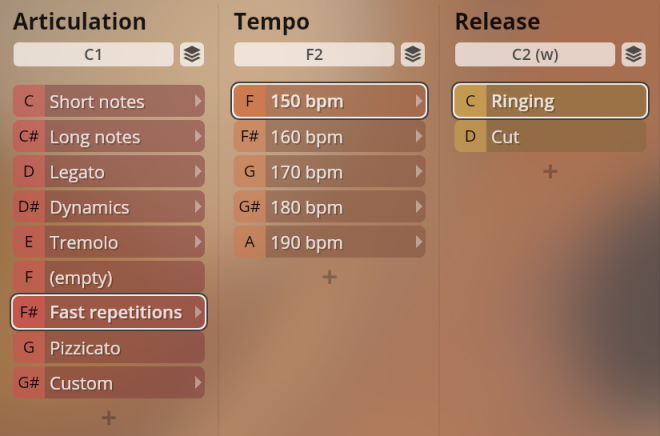
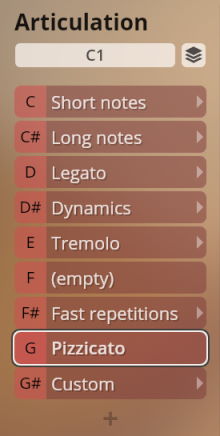
This Articulation does not yet contain any samples. It provides 6 slots ready for you to configure presets of your own.
